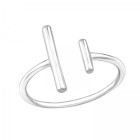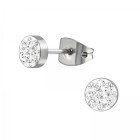About our products
Here you will find useful information about the most common materials, components and general jewelry-making techniques we are using on our products, feel free to contact us if you have further questions about any of our products.
Our Metals
 | 925 Sterling SilverEach original Elf925 creation is guaranteed to boast a minimum of 92.5% pure silver. All our sterling silver jewelry is stamped 925. Despite its beauty and quality, Sterling Silver is still a far more affordable commodity than Gold or Platinum and offers higher potential margins for retailers. |
 | 316L Surgical SteelSurgical Steel is extremely durable and resistant to scratches, rust, and general wear & tear. Neither air nor moisture exposure will compromise the luster of 316L Surgical Steel. Discover the collection here. |
Our Gemstones, Crystals and Pearls
 | Genuine European CrystalsThe majority of Elf925’s jewelry, including our immensely popular “La Crystale” brand, are made using genuine European crystals. Available in 60+ color variants, and broad range of shapes and sizes, crystals are the perfect components to add colorful sparkles to jewelry for both children and grown-ups. |
 | Cubic ZirconiaCommonly known as CZ, Cubic Zirconia so closely resembles real diamonds that few people can tell the difference. By integrating Cubic Zirconia into our jewelry we are able to give our products that enviable “diamond-like” sparkle and feel. Find out what we mean here! |
 | Synthetic OpalThese beautiful Lab-grown Opals have similar properties to naturally mined stones. Their unique feature of vertical growth patterns, coupled with perfect color vibrancy allows us to create stunning pieces that could be mistaken for genuine opal. Discover the collection here. |
 | Semi-precious GemstonesThe Elf925 teams go the extra mile to bring you the very best jewelry, with a broad selection of 100% natural and genuine semi-precious stones. These include Amazonite, Amethyst, Chalcedony, Black Onyx, Labradorite, Sodalite and Malachite. All items with semi-precious stones have a watermark on the product for your peace of mind. See the collection here. |
 | Imitation PearlsImitation, or synthetic, pearls are man-made components that are designed to resemble real pearls. Several methods are used to create imitation pearls from materials such as crystal, glass and plastic. Being man-made their shapes and colors are consistent throughout every piece. |
 | Freshwater PearlsAs opposed to imitation, freshwater pearls are naturally grown, they usually come from shells farmed in freshwater which is where their name originates from. As a natural material, they are not uniform in size and every piece will be slightly different in shape and size, adding a unique touch to every item. You will be easily able to identify items made with freshwater pearls through the watermark on the product picture. |
Our Finishings
 | EpoxyThe secret to our jewelry's colorful appeal lies in something called Epoxy - a resin-based paint used to create charming, colorful patterns on our jewelry. Most of our Epoxy-coated designs can be found in our children's collection where a wide variety of playful designs awaits to be discovered. |
 | Diamond-Cut FinishDespite the fancy name, a diamond-cut finish is merely a process whereby small notches and grooves are being cut into the jewelry to enhance light refraction and give the pieces extraordinary sparkle, without the addition of any stones. |
 | Diamond Dust FinishAnother fancy name for a relatively common technique in jewelry making. Diamond Dust is a type of finish whereby microscopic glass flakes are deposited onto the pieces, these flakes reflect the light to create a diamond-like look and giving the impression that the jewelry has been “dipped” in glitter. |
 | Brushed FinishBrush is a type of matte finishing that gives the metal a sleek, organic look. This type of finish requires specialized equipment, typically special polishing wheels used on rotary tools, which leave a fine texture on the surface of the jewelry and create a unique satin look. Brush-finished items have a heavier definition on the visible strokes. When touched, you should be able to feel the stroke marks. |
 | Oxidized FinishOxidation is the natural process of silver darkening over time. Nowadays, jewelers are professionally oxidizing metals in order to give the jewelry a blackened, antique look. This creates an appealing “gunmetal” color, which gives colored stones and raised areas a strong “pop.” Discover our oxidized finish designs. |
Our Platings

Electroplating, also known as galvanic deposition is common practice in the global jewelry industry, and Elf925 is no exception. We carefully plate each delicate piece of Silver jewelry that leaves our facility, providing superior finish and protection against tarnishing, rust, and scratches. Plating also adds a bonus layer of shine and luster.
 | What is E-Coating?Otherwise known as electro-deposition or electro-coating, e-coating is a popular method that relies on using an electrical current to coat a metal surface with an organic lacquer. This ultra-fine layer of plastic is a form of plating, designed to significantly improve your jewelry's tarnishing resistance. |
 | What is Silver Plating?Applying an extra layer of pure silver to our sterling silver jewelry, gives the item an extra layer of shininess and added protection against scratches and daily wear & tear. Unless specifically stated otherwise, this type of plating will almost always be two microns thick. |
 | What is Gold Plating?At Elf925, we specialize in superior gold-plating whereby we deposit a thin layer of almost pure gold onto the surface of the jewelry's sterling silver base. Gold plating is a delicate art, and there are various thicknesses available depending on the specific type of jewelry and your needs. For example, rings are typically plated with a minimum of 0.25 Microns or more, seeing as these items are more exposed to wear and tear daily. Most other items are flash gold-plated. Discover our gold-plated designs. |
 | What is Rose-Gold Plating?Rose gold, often referred to as Pink Gold, is usually an alloy of gold and copper. One of the most common rose gold compositions is 75% gold and 25% copper, the recipe for 18 karats rose gold. Rose gold can never be made of 100% gold, as copper is needed to give it its pink hue. Discover our rose-gold-plated designs. |
 | What is Rhodium Plating?Rhodium is a silver-white hard metal found in platinum ores. This noble metal offers wearers a stunningly bright finish with long-lasting wear. When applied as plating, Rhodium delivers unmatched durability and brilliant brightness, naturally boosting the aesthetics and longevity of any metal jewelry. Rhodium is slightly darker than silver and brings out the strikingly bright colors of crystals or cubic zirconia stones. Discover our rhodium-plated designs. |